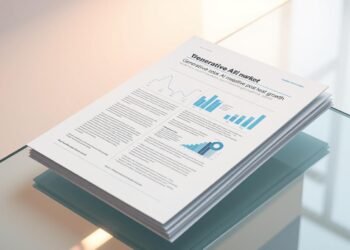Have you ever wondered how much the final step of getting packages to your doorstep impacts the global economy? The last-mile delivery sector is booming, reshaping how businesses and consumers interact. With a valuation of $132.71 billion in 2022, this industry is projected to grow at 8.8% annually through 2030.
North America leads with a 31% market share, while Asia-Pacific shows the fastest growth at 11.1% yearly. E-commerce drives 70% of revenue, with retail dominating 57% of the sector. Despite challenges like labor shortages, innovations like drones and autonomous vehicles are changing the game.
The pandemic accelerated demand by 36%, proving how vital this service is. Companies like Amazon are investing heavily, offering small businesses $27K yearly partnerships to expand their reach. The future of logistics is evolving—fast.
Key Takeaways
- The global last-mile sector was valued at $132.71 billion in 2022.
- North America holds the largest market share at 31%.
- Asia-Pacific is growing the fastest with an 11.1% annual rate.
- E-commerce makes up 70% of revenue in this space.
- Amazon leads strategic investments to support small businesses.
Understanding the Last-Mile Delivery Market Landscape
Consumer expectations for fast, reliable shipments are reshaping logistics strategies. The final stage of shipping goods accounts for 41% of total logistics costs, making it a focal point for innovation. Businesses now compete on speed, with 68% of shoppers willing to pay extra for guaranteed arrival times.
Definition and Market Scope
This segment covers the movement of goods from distribution hubs to end users. Urban areas face unique hurdles, with 43% of delays tied to traffic congestion. Micro-fulfillment centers cut travel distances by 38%, offering scalable solutions for crowded cities.
Significance in Modern Supply Chains
The “Amazon Effect” has raised the bar, with same-day shipping becoming standard. Over 75% of customers say late arrivals hurt their satisfaction. To meet demand, companies invest in route optimization and electric fleets, balancing cost and efficiency.
Global Last-Mile Delivery Market Size and Projections
Global commerce hinges on efficient transportation, especially in the critical phase of getting goods to consumers. The sector’s valuation hit $132.71 billion in 2022, with innovations and shifting consumer behaviors driving rapid expansion.
2022 Benchmark Figures
Autonomous technology emerged as a standout performer, growing at a 17.6% CAGR. Retail and e-commerce dominated revenue streams, while urban logistics faced challenges like traffic delays and rising fuel costs.
2030 Growth Forecast
By 2030, drone deliveries are projected to surge at a 22% CAGR, outpacing traditional methods. Consumer-to-consumer (C2C) models show an 11.4% growth rate, exceeding B2B’s 9.2% due to peer-to-peer platforms.
Compound Annual Growth Rate Analysis
Cost-cutting strategies, like micro-fulfillment centers, aim to offset inflation’s potential 2–3% drag on profitability. These trends highlight a sector balancing innovation with economic pressures.
Key Drivers Fueling Market Expansion
Urban lifestyles and digital shopping habits are rewriting the rules of logistics. The push for faster, greener, and more efficient solutions is transforming how businesses operate. Three forces stand out: e-commerce growth, tech innovation, and shifting urban retail models.
E-Commerce Boom and Consumer Expectations
Online shopping now demands same-day or even 2-hour windows for goods. Over 68% of shoppers pay extra for speed, pushing retailers to optimize networks. BOPIS (Buy Online, Pickup In-Store) grew 28% yearly, blending digital and physical retail.
Technological Advancements in Logistics
AI route planning and micro-mobility handle 23% of urban shipments. Businesses using automation report 30% lower costs. Drones and robots are no longer futuristic—they’re solving real congestion challenges.
Urbanization and Changing Retail Patterns
By 2050, 68% of people will live in cities. This trend sparked a 39% rise in urban fulfillment centers since 2020. The “15-minute city” concept now shapes delivery expectations, with hyperlocal hubs cutting transit times.
Last-Mile Delivery Market Segmentation by Service Type
Not all shipments follow the same path—service models shape how products move to their final stop. Businesses and consumers interact through three main channels, each with distinct operational and economic characteristics. Understanding these segments reveals why certain approaches dominate while others emerge as niche solutions.
Business-to-Consumer Dominance
B2C commands a 57% revenue share, fueled by e-commerce giants and direct-to-customer retail. Same-day expectations pushed 72% of retailers to adopt localized fulfillment centers. Urban areas see the highest density, with 68% of metro residents receiving at least three B2C packages weekly.
Business-to-Business Applications
While smaller at 28% of volume, B2B logistics prioritize reliability over speed. Medical suppliers and manufacturing parts account for 43% of these shipments. Contract-based pricing and scheduled routes differentiate this segment from time-sensitive consumer deliveries.
Emerging Consumer-to-Consumer Trends
Platforms like Facebook Marketplace facilitate 39 million monthly peer transactions, driving the C2C segment’s 11.4% CAGR. Services like Roadie connect travelers with parcel transport needs, but insurance gaps remain—only 22% of C2C carriers offer damage protection. NotaryCam’s certified document partnerships show how niche applications fill specific gaps in this growing space.
Technology Adoption in Last-Mile Operations
Cutting-edge tools are transforming the final leg of product transportation. Businesses now deploy advanced systems to enhance speed and reduce costs. Three technological approaches dominate this evolution.
Non-Autonomous Vehicle Solutions
Traditional fleets still handle 83% of shipments but now feature smart upgrades. Electric vans with route optimization solutions cut emissions by 41%. Companies like FedEx report 27% faster drop-offs using real-time traffic algorithms.
Autonomous Delivery Systems Growth
Self-driving vehicles will account for 12% of delivery fleets by 2025. Nuro’s zero-occupant pods completed 50K grocery runs in 2022. Regulatory hurdles remain, but pilot programs show 34% cost savings over human drivers.
Drone Delivery Pilot Programs
The drone sector is projected to hit $7.9 billion by 2027. Zipline’s medical delivery network serves 250K Rwandan patients annually. Walmart expanded drone drops to six states after FAA Part 135 certification, while Alphabet’s Wing handles 10K monthly suburban shipments.
Application Areas Driving Demand
From retail to healthcare, efficient movement of goods shapes modern business success. Industries rely on tailored logistics to meet rising expectations for speed and precision. Three sectors stand out for their unique demands and growth trajectories.
Retail & E-Commerce Sector Leadership
Online shopping fuels 70% of shipments, with giants like Amazon setting same-day standards. Local fulfillment centers cut transit times by 38%, while BOPIS (Buy Online, Pickup In-Store) grows 28% annually. Urban areas see the highest demand, with 68% of metro residents receiving weekly packages.
Food & Beverage Delivery Acceleration
Meal kits and grocery apps surged 43% during the pandemic. Companies like DoorDash now partner with 450K restaurants, using AI to optimize 15-minute drops. Cold-chain innovations ensure freshness, with 92% of consumers prioritizing on-time arrivals for perishables.
Healthcare Logistics Requirements
The healthcare logistics sector will hit $12.4B by 2025. Pfizer’s vaccine network delivered 1.3B doses globally, while Zipline’s drones save 12K lives annually with blood shipments. Telemedicine kits grew 39%, and McKesson’s temperature-controlled solutions ensure drug safety.
Regional Market Performance Analysis
Geography plays a pivotal role in how goods reach consumers across continents. While global networks connect markets, local infrastructure and regulations create distinct operational landscapes. Three regions demonstrate particularly noteworthy approaches to modern logistics challenges.
North America’s Market Leadership
With 31% global share, this region prioritizes speed and scale. Same-day fulfillment centers now operate within 10 miles of 65% urban consumers. DHL leads in sustainable solutions, deploying 27,000 StreetScooter electric vans across U.S. and Canadian routes.
Asia-Pacific’s Rapid Growth Trajectory
An 11.1% annual growth rate reflects booming e-commerce demand. Cities like Shanghai achieve 92% on-time rates through AI-powered traffic avoidance. Motorcycle fleets maintain cost efficiency, handling 58% of Jakarta’s urban shipments.
European Sustainability-Focused Approaches
Regulations drive green trends, with Paris banning diesel vehicles by 2024. Packaly’s bicycle courier network expanded 140% since 2021 across 12 EU capitals. The 2035 combustion engine phase-out will accelerate electrification, aligning with 63% consumer preference for eco-friendly options.
COVID-19 Impact on Last-Mile Delivery Services
Lockdowns created a seismic shift in consumer behavior that permanently altered supply chains. The pandemic accelerated digital adoption, with 73% of shoppers maintaining heightened online ordering habits post-crisis. This surge tested operational limits while revealing innovative solutions.
Pandemic-Driven Demand Surge
Hybrid work models sustained 22% annual growth in residential shipments. Urban areas saw the sharpest spike, with apartment complexes receiving 3x more parcels than pre-2020 levels. Dark stores—retail spaces converted to micro-fulfillment hubs—increased by 47% to meet neighborhood demand.
Operational Challenges and Adaptations
Labor shortages peaked at 38% vacancy rates during outbreaks. Companies responded with contactless protocols now adopted by 89% of providers. Route optimization tools became essential, reducing failed attempts by 27% through AI-powered address verification.
Long-Term Industry Transformations
The crisis cemented expectations for flexibility—same-day options grew 140% since 2019. Micro-fulfillment investments reached $3.2 billion as businesses localized inventory. These trends suggest lasting changes, with the market projected to maintain 8.4% growth through 2025 despite economic headwinds.
Analysts forecast permanent shifts, including 62% of retailers retaining hybrid delivery/pickup models. The pandemic didn’t just change logistics—it proved adaptable networks could thrive under pressure.
Competitive Landscape and Market Share
Innovation is reshaping how goods reach consumers, with over 1,200 startups competing in this dynamic space. Established logistics companies now face pressure from agile newcomers offering specialized services. The sector’s 8.8% annual growth attracts $4.2 billion in venture funding, creating a vibrant ecosystem of competing approaches.
Key Players and Strategic Positioning
Starship Technologies deployed 1,000+ autonomous robots across 20 university campuses, completing 2 million food deliveries. Their wheeled units operate at 85% lower cost than human couriers. Meanwhile, Veho’s $1.5 billion valuation reflects demand for their white-label platform serving 15 major retailers.
Recent Industry Developments
Jokr’s 15-minute grocery model expanded to 10 U.S. cities before shifting to B2B wholesale. Such rapid pivots highlight evolving consumer trends. Bond secured $32 million for luxury brand deliveries, offering climate-controlled transport and premium packaging.
Emerging Startups and Innovators
New entrants focus on niche solutions like refrigerated locker networks and AI-powered load balancing. The average Series A funding round reached $28 million in 2023, up 37% from pre-pandemic levels. This investment surge indicates strong confidence in alternative distribution models.
Delivery Time Preferences and Market Response
Speed has become the new currency in modern logistics, with consumers voting with their wallets for faster options. Over 68% of shoppers now abandon carts when faced with delivery times exceeding two days, creating intense demand for accelerated fulfillment.
Standard Delivery Options Evolve
Traditional 3-5 day shipping now serves as the baseline rather than the benchmark. Walmart redefined expectations with its 3-hour delivery promise, covering 80% of U.S. households through 4,700 stores functioning as micro-fulfillment hubs. This model cuts average transit distances by 63% compared to regional warehouses.
The Same-Day Revolution
Faster options are growing at a 20% annual rate as companies prioritize efficiency. DoorDash’s 35-minute convenience store deliveries now reach 85% of urban consumers, while Shopify’s Local Delivery app saw 340% merchant adoption growth in 2022. These services leverage existing retail footprints to minimize transit times.
Forward-thinking retailers now use predictive inventory placement, analyzing zip code purchase patterns to pre-position top-selling items. This approach reduces same-day fulfillment costs by 28% while improving reliability—a win-win solution for businesses and customers alike.
Cost Structure and Pricing Dynamics
Balancing speed and affordability defines modern logistics pricing strategies. Companies now dissect expenses like fuel (24% of costs), labor (38%), and tech investments to optimize margins. Subscription models, like Amazon Prime’s $139/year plan, lock in customer loyalty while stabilizing revenue.
Operational Expense Breakdown
Urban routes cost 43% more due to traffic and parking fees. Electric fleets cut fuel bills by 31%, but upfront investments remain high. Automation solutions, like route planners, reduce labor dependency—a win for long-term savings.
Pricing Strategy Variations
Peak-period surge pricing adds 15–20% fees during holidays. White-glove services command 50% premiums for fragile items. Meanwhile, 39% of retailers offer carbon-neutral shipping for a $2–5 upcharge, appealing to eco-conscious shoppers.
Environmental Considerations in Last-Mile Logistics
Eco-friendly practices are no longer optional in modern supply chains. Companies face mounting pressure to reduce emissions while maintaining service quality. The final transportation stage accounts for 28% of sector-wide carbon output.
Carbon Footprint Challenges
Urban routes generate 43% more emissions than suburban deliveries. Traffic congestion adds 19% to fuel consumption in metro areas. Smart solutions like optimized routing cut emissions by 31% while improving delivery times.
Electric Vehicle Adoption
The EV fleet market will grow 24% annually through 2027. Amazon ordered 100,000 electric vans from Rivian, while UPS deployed 10,000 StreetScooters. This trend aligns with 63% of consumers preferring green shipping options.
Sustainable Packaging Initiatives
Loop’s reusable containers eliminate single-use waste for brands like Tide. Amazon’s Frustration-Free Packaging reduced materials by 33% since 2015. NotPla’s seaweed-based wraps decompose in 6 weeks, offering plant-based alternatives.
Right-sized boxes save 19% space per shipment, boosting transport efficiency. With 43% of shoppers demanding minimal packaging, these innovations address both environmental and customer expectations.
Future Trends Shaping the Last-Mile Delivery Market
The race to redefine efficiency in product transportation is accelerating. Three emerging approaches are transforming how businesses meet consumer demands for speed and reliability. These innovations address urban congestion, rising costs, and environmental concerns.
Micro-Fulfillment Centers
Gopuff operates 500+ compact warehouses strategically placed near high-density areas. These hubs reduce transit distances by 38%, enabling 15-minute drops for essentials. Dark stores—retail spaces converted to fulfillment-only facilities—now account for 47% of urban logistics footprints.
Inventory management remains a challenge, with 63% of operators citing space constraints. Smart shelving systems and vertical storage help maximize capacity. The model proves especially effective for convenience items, with 7-Eleven’s partnership network achieving 30-minute delivery windows.
AI-Powered Route Optimization
Advanced algorithms now process real-time traffic, weather, and demand patterns. Companies using these solutions report 27% fewer late arrivals. Machine learning predicts peak periods, adjusting fleet deployment 72 hours in advance.
Dynamic routing cuts fuel costs by 19% while improving driver efficiency. The technology also reduces failed delivery attempts through automated address verification. These systems become smarter with each shipment, continuously refining performance.
Hyperlocal Delivery Networks
Growing at 24% annually, these systems leverage neighborhood resources. Bike couriers and foot messengers handle 58% of downtown shipments in major cities. The approach minimizes carbon emissions while ensuring rapid turnaround.
Local businesses benefit through shared logistics platforms. A single fulfillment center can service multiple retailers within a 3-mile radius. This collaboration model cuts operational expenses by 32% for small enterprises while expanding their reach.
Conclusion
Tomorrow’s supply chains will look nothing like today’s networks. The sector’s $258B projection at 8.8% growth reflects seismic shifts in technology and consumer demands.
Success hinges on three pillars: AI-driven logistics, eco-friendly fleets, and hyperlocal networks. Autonomous solutions like drones will handle 22% of urban shipments by 2025, while Asia-Pacific dominates post-2027 with its 11.1% annual expansion.
Challenges persist—labor costs, urban regulations, and thin margins pressure providers. Yet COVID permanently reshaped expectations, with 62% of retailers keeping hybrid models. The last-mile delivery market isn’t just evolving; it’s redefining commerce itself.
FAQ
What defines the last-mile logistics sector?
This sector covers the final step in shipping, moving goods from distribution hubs to end customers. It plays a crucial role in supply chains, especially for e-commerce businesses.
How fast is this industry growing globally?
Projections indicate strong expansion, with the sector expected to maintain a high compound annual growth rate through 2030. Rising online shopping demand fuels this trend.
Which technologies are transforming final-stage logistics?
Innovations like drone pilots, AI routing tools, and electric fleets are reshaping operations. These advancements boost efficiency while addressing environmental concerns.
Which regions lead in adoption and innovation?
North America currently dominates, while Asia-Pacific shows the fastest growth. Europe stands out for sustainable approaches like cargo bikes and green hubs.
How did COVID-19 affect this industry?
The pandemic accelerated demand for home shipments while challenging operators to adapt quickly. Many implemented contactless protocols and expanded capacity.
What are emerging trends to watch?
Key developments include neighborhood fulfillment centers, dynamic routing algorithms, and ultra-fast local networks. These aim to cut costs and improve speed.
How do businesses handle environmental impacts?
Companies increasingly adopt eco-friendly measures like electric vans, optimized routes, and recyclable packaging to reduce carbon emissions.
Who are the major service providers?
The competitive field includes global carriers like FedEx, specialized startups like Roadie, and retail giants such as Amazon with their own networks.








